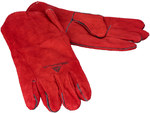Welding gloves
(10)
As an occupational health and safety wholesaler, we provide comprehensive solutions in the field of personal and collective protection of employees. We supply companies from many industries with work clothing, warning and information boards, fall protection systems and head, leg and hand protection. We offer protective gloves for various applications, including welding. Welding gloves have increased mechanical and thermal resistance. See available models and order the product you need online.
The most important criteria for choosing welding gloves
While every welding glove provides protection while welding, not all gloves offer the same level of protection and dexterity. That's why there are different types of welding gloves available in the market. The choice of a given type should be matched to:
- welding methods,
- processed materials,
- planned working time,
- individual needs and preferences of the welder.
It is worth remembering that welding gloves must meet the requirements of specific standards (mainly the EN 12477 standard). This is essential if they are to promote safe, precise and comfortable welding.
Type A and B welding gloves – which ones to choose?
There are two main types of welding gloves. Type A welding gloves are thick, extremely durable and resistant to abrasion, cuts, punctures and very high temperatures. They provide effective protection of hands against flame during MIG/MAG welding. However, they may limit the dexterity of the fingers. Therefore, in precision welding methods, such as TIG, relatively light and thin type B welding gloves are used. The welder has full freedom of movement in them, but is slightly less protected than when wearing type A gloves. In health and safety stores, you can find also type A/B welding gloves. it is a hybrid combining the properties of both types. Provides a centered level of protection and dexterity.
Leather, synthetic and aluminized gloves
The production of welding gloves uses materials that provide resistance to cuts, punctures and high temperatures. Manufacturers mainly use natural leather, aluminized fabrics and modern synthetic materials. • Leather welding gloves are durable, flexible and comfortable to wear. They provide good protection against high temperatures, sparks and splashes. They are made of grain or split leather. They are used for production, among others: cow, goat, pig and lamb skins. Long gloves made of split leather are suitable for MIG/MAG methods, and shorter ones made of grain leather are suitable for TIG welding. Models intended for welding in winter conditions have an additional lining.
- Gloves made of synthetic materials are light, flexible and highly resistant to cuts, punctures and heat.
- Gloves made of aluminized fabrics are resistant to extremely high temperatures and radiation, which is why they are often used, for example, in arc welding.
Need help choosing welding gloves? Contact us! Onninen specialists provide advice on the selection of gloves, clothing and other solutions that guarantee the safety and comfort of the welder's work.





